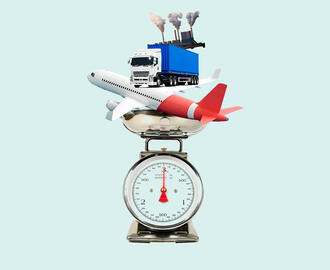Credit: MAX 3D Design / Shutterstock
Toilet paper, cleaning supplies, and eggs — these consumer staples were impossible to find in the early days of pandemic lockdown, prompting widespread fears about the health of the global supply chain.
Yet while there were major hiccups, many of the product shortages — toilet paper, most notably — had less to do with serious supply chain glitches and more to do with changing patterns of demand, panic buying, and a shift in how consumers wanted to buy goods.
In his recent book, “The New (AB)normal: Reshaping Business and Supply Chain Strategy Beyond COVID-19,” Yossi Sheffi, director of the MIT Center for Transportation and Logistics, makes the case that the COVID-19 pandemic didn’t actually break the global supply chain, it simply revealed underlying cracks and accelerated shifts that were already well underway.
Manufacturers have been grappling with the need for greater end-to-end visibility across their supplier networks and trying to diversify sourcing strategies, including a shift away from China to more localized and distributed production.
They have also been investing in technologies to shore up their online and e-commerce game to accommodate shifting demand patterns and changing consumer behavior. As a post-COVID-19 world begins to emerge, these transformations are no longer nice-to-haves, but rather have become a lifeline for sustaining business.
Sheffi, a professor of engineering systems at MIT, acknowledges that pandemic-induced spot shortages, nationwide lockdowns, disruptions to global transportation patterns, and the need for social distancing created unprecedented challenges in 2020. Nevertheless, he maintains that supply chains remained remarkably resilient, especially among industries and companies already invested in agile business that had a willingness to adapt processes and revenue models to capitalize on the new normal.
“Contrary to the media’s apocalyptic assessment, the COVID-19 pandemic did not break America’s or Europe’s food supply chains — the retail shortages experienced by consumers were only temporary,” he writes. “Looking behind the headlines can reveal the real situation — a tectonic shift in where people got all their food and a shift in what people wanted to purchase.”
Positive momentum
As the pandemic played out, companies accelerated efforts to deploy digital technologies to automate their supply chains, control costs, and minimize human contact during transactions while reducing the density of workers in offices, plants, and warehouses.
Creating end-to-end visibility across the continuum of procurement, manufacturing, and logistics processes had been a top priority for many companies, even well before the pandemic. Those mandates, coupled with advances and the declining cost of key technologies such as the Internet of Things, mobile internet, robotics, cloud computing, and artificial intelligence, came together for many forward-looking companies for which the pandemic was a catalyst for critical change.
Here’s a look at where Sheffi saw positive momentum:
Achieving end-to-end visibility. A key necessity for a well-run supply chain, in a pandemic or not, is complete visibility into what’s taking place, using data to gain insight. Companies need to know as early as possible if there is a problem, be that a late shipment, quality issue, or some unforeseen delay with customs.
Related Articles
Historically, it’s been difficult to achieve that level of visibility due to independent and disconnected systems that don’t easily share data. It takes more than one company implementing sensors and the requisite technology backbone to achieve continuous visibility into the flow of goods, Sheffi writes. And most companies also haven’t fully mapped their supply chains, so they don’t know who their deep-tier suppliers are.
Yet there are organizations making progress. Sheffi cites Procter & Gamble as one example of a firm successfully leveraging IoT, data, and analytics to get a snapshot of what its customers are doing. For example, in analyzing data directly collected from washing machines that were part of a pilot program, P&G was able to determine that customers weren’t buying its Tide detergent and hoarding it — they were simply doing more loads of laundry under stay-at-home directives.
Eliminating paperwork and other hands-on handoffs. While much of supply chain documentation is still maintained in paper forms like a bill of lading, companies have been steadily moving toward standardized electronic document systems and contactless transactions. Blockchain is one technology Sheffi believes is gaining traction as a way to create a secure, immutable record that doesn’t require a central managing authority while ensuring integrity of transactions.
On the product development front, companies have been gravitating to tools like 3D modeling programs, digital files, and high-resolution video to collaborate virtually and speed up the design process — a trend that started well before the 2020 lockdowns.
Increasing use of automation. Companies were sold on automation to garner efficiencies on the factory floor or to accelerate deliveries to be more competitive in e-commerce, and Sheffi maintains COVID-19 simply accelerated the trend. For example, companies like Tyson Foods had bought into automation and robotics in a big way to be more efficient at deboning, packaging, and palletizing its chicken products.
In the automotive space, BMW maintains a range of robots to do everything from unpacking pallets of parts to loading goods on shelves and moving parts and containers from place to place. The automotive company’s paperless, contactless system employs QR codes on parts containers and integrated sensors on employee gloves to alert them to what’s in containers without having to physically touch them.
Robots also play a role in the logistics end of the supply chain, streamlining the pick and packing process, continuously tracking inventories with flying drones, or serving in last-mile delivery. “The promise of next-day delivery no longer impresses customers in a world where same-day and even two-hour services are becoming more common,” Sheffi writes. “Automation holds the promise of faster processing and delivery without increased costs.”
Automation can also garner efficiencies for knowledge workers. Robotic process automation software can handle repetitive office work like invoice approval, collating data for weekly reports, reminders, and reordering of supplies by creating bots through scripted actions and simple rules. Companies like Zurich Insurance Group are touting RPA for automating the underwriting of standard boilerplate policies so commercial underwriters can spend more time on complex policies, Sheffi writes.
Rethinking the China relationship. Increasing labor costs had many companies reconsidering China-based sourcing relationships, and the pandemic exacerbated their plans. Some companies started relocating operations outside of China to other Asian countries or are pursuing a strategy of diversification to “China plus one” (at least one other country in the mix). Others have begun to reshore to the U.S. and the EU for a variety of reasons — among them, better control over product and material quality as well as closer proximity to markets and customers.
To create even greater resiliency, companies like BASF have established networks of plants around the world, allowing them to redeploy capacity in support of changing needs or recovery from disruption. “In a whack-a-mole world where pandemics, nationalistic trade policies, and local disasters hit different locations at different times to impede the production, flow, or consumption of goods, no single source location can be safe,” Sheffi writes. “Instead, a multishore network of locations provides local presence to serve local customers … as well as the resilience required to manage risks of disruptions to capacity.”
Embracing agile. Many companies doubled down on agile principles to change the way they work during the pandemic and to reinvent their businesses. Sheffi describes three categories of agility:
- Scale agility — when companies find ways to make more of existing products to meet surging demand.
- Asset agility — used to unearth new uses for underutilized assets and provide products and services closely related to the preexisting business.
- Scope agility — when firms pivot completely to build entirely new types of products.
What comes next
As companies and industries prepare to move forward, Sheffi believes a number of COVID-19-induced trends will have lasting impact.
Omnichannel retail and e-commerce. With the squeeze on physical retailers, companies will continue to adapt and innovate digital experiences. Virtual fitting rooms, augmented reality apps for viewing how a product looks in a home setting, and omnichannel experiences that allow customers to interact with a retailer from any physical or electronic channel will become the norm. BOPIS (Buy Online, Pick Up in Store), BOSFS (Buy Online, Ship From a Store), and Ship From Store became popular during the pandemic and will stick around due to customers’ preference for speed and convenience.
The rise of platforms. Just as Airbnb and Uber opened up the hospitality and transportation markets to any willing participant, emerging platforms will enable independent stores to compete online and capture much broader markets. Sheffi cites a collaboration between C&S Wholesale grocers and Instacart as one example: The platform offers e-commerce and same-day delivery solutions to more than 3,000 independent grocery retailers. Similarly, Bookshop is a third-party platform used by independent bookstores for online sales.
New role for “dark stores.” Unused retail space is being repurposed as fulfillment centers as e-commerce continues to grow. DSW started shipping orders out of closed shoe stores, and Walmart took over a shuttered Sam’s Club in North Carolina, remaking the facility into an e-commerce fulfillment center.
Connectedness rather than self-reliance. One critical lesson from the COVID-19 experience is that a focus on self-reliance can be a recipe for failure if disaster strikes.
Sheffi said many of the trends accelerated by COVID-19 have roots in improving connectedness, whether it’s IoT delivering critical insights through data or mobile devices or collaboration apps that link people to people, anywhere, at any time. Improved connections enable visibility, remote management, and working from home while giving companies the flexibility and agility they need to deal with disrupted supply and demand and to capture long-term global opportunities.
“Although COVID-19 may have exposed the fragile links lurking in the global economy, it also accelerated the adoption of a great many technologies and practices that will make the global economy more robust over time,” Sheffi concludes. The result, he contends, is the new (ab)normal supply chain.
The New (AB)normal, Reshaping Business and Supply Chain Strategy Beyond COVID-19



